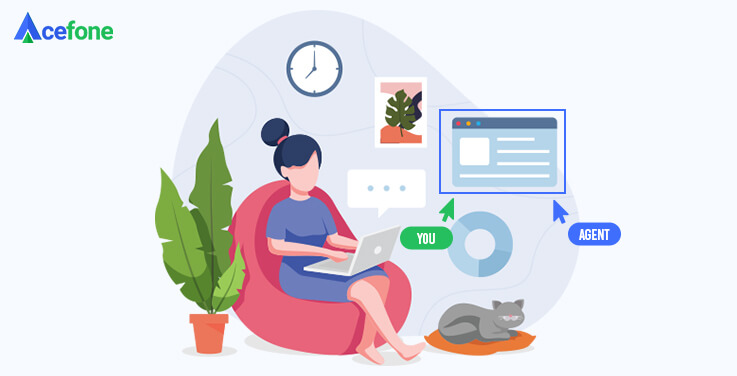How easy would customer support be if you could be on the same page as the customer, literally? Imagine, you’d be able to guide them to a solution while seeing the exact problem.
What once seemed like a dream too good to be true is now absolutely possible.
So, what is co-browsing?
In the literal sense of the word, you’d conjure up an image of an agent sitting side-by-side with a client, surfing the same page together. However, that wouldn’t be quite accurate.
Co-browsing is actually short for collaborative browsing, which allows agents to navigate the same page as the customer––virtually. It is also a secure way of support as only the customer controls the navigation and the agent simply supervises. Moreover, clients can hide other applications on their devices by only sharing a specific tab or window.
How does co-browsing work?
Based on Web Real-time communication technology, or WebRTC for all you tech-savvy people, co-browsing requires no downloads, installation, or even plugins to work with its full potential. Unlike online streaming, it is actually a browser-based technology that transmits simple HTML codes to initiate a session between two browsers and deliver instant communication.
Since it is based on the cloud, the technology doesn’t require any on-premise hardware. It is the use of HTML, to pass data between customers and agents, that makes it instant. And a one-time install javascript that can render the customer’s browser HTML inside an iframe for the agent helps to do away with plug-ins.
We know what you’re thinking––if multiple people are using the same page at the same time, the website might slow down. But it doesn’t! This is because no data is transferred to the agent until the co-browse session is initiated.
Why should you be using co-browsing?
Undoubtedly, the COVID-19 pandemic made it hard for businesses to retain the same quality of customer service as before—even more so with the sudden shift to a remote working environment. Agents at home lacked the resources and proper equipment to accomplish tasks. This definitely made customer satisfaction suffer.
An article by Forbes states that co-browsing shoots up the customer satisfaction rate to up to 89.3%, which is six points higher than the average.
The reason? Quite apparent—agents are able to know exactly where the customer is stuck, which leads to an effortless conversation and quicker resolutions. With constant visual cues, agents can guide the customer to the solution with ease.
Another trouble businesses ran into during the pandemic is the crunch of funds. Many firms hit an all-time financial low, and yet needed superior technology to help perform better than their competitors.
A report by Aberdeen Group shows how co-browsing helped reduce support costs while also increasing the customer satisfaction rate. It can be a pivotal technology for any support center, being easy to use and quick to the solution.
How does co-browsing empower your agents?
Collaborative browsing is loaded with useful features to help agents in most situations. It gives your team full insights into customer problems, ensuring that the process is carried out smoothly. Let’s take a look at a few unique features that agents are entitled to.
- Remote control: Customers can grant system control to agents anytime during the session. This lets them perform certain actions which the customer might not be able to, thereby reducing the time and effort involved in the task.
- One-click request: It only takes a single click for the customer to send a co-browse request to an agent. This makes the process effortless and smooth for the customer and easy for the agent to explain. No downloads, no wait time, no lag.
- Simultaneous browsing: While the agent and the user are in the co-browse mode, any URL that the customer accesses is also accessible by the agent. Thus, while co-browsing is limited to one tab, it is not bound to a single page. As long as the customer stays on the same tab, the agent is able to monitor every single activity, providing him with the information required to solve the problem.
- Co-scrolling: With co-scroll, both parties move on the webpage, or scroll through it, in real-time. So, they can hover over different web elements for effective communication.
- Live annotations: Agents also have the option to take notes or highlight certain elements while they are in the co-browse mode. They can even draw, like encircling or drawing an arrow to point something out, to lend clarity to the customer and handle the issue with ease.
- Live chat: During the session, both parties can communicate via the chat option. This enables the agent to address any additional issues faced by the customer or explain the solution more thoroughly.
How does co-browsing empower the customer?
In addition to the agents, co-browsing offers many handy features at the customers’ end too. While the agent is able to see the customer’s screen, the customer is also capable of knowing what the agent is doing. This develops mutual trust, enabling the agents to perform better. Let’s look at some of these features:
- Session control: The user can give the client complete control of the co-browse session. They can then decide to give the agent partial control or dictate when to give or restrict access anytime during the conversation. They can even restrict the agents from switching to other tabs.
- Mask data: Many customers have cyber-security concerns. Co-browsing allows them to mask their data and hide confidential information that they don’t want the agent to see.
- Multi-device compatibility: Another major advantage for customers is the ability to access co-browse mode across various devices. This ensures that the agent is able to provide support to the customer 24×7 irrespective of the device they are on.
- Marking tools: Providing visual cues to the agent can be crucial when trying to explain a complicated problem. Customers can take advantage of various marking tools such as the highlighter pen, pointer, drawing brush, etc. to explain and highlight key elements on the webpage.
Can different industries use co-browsing?
No matter what industry you work in or how you tend to your customers, customer interaction is always going to be vital for your business. And hence, co-browse technology can be a huge advantage. Let’s take a look at a few industries and how they benefit from them.
- Banking sector: One of the most common issues customers of the finance industry face is filling up forms. With co-browsing, however, the task is barely an inconvenience. With the help of a skilled agent, the user can be guided through the entire process in a jiffy. The agents can also help customers upload the right document and avoid minor mistakes that delay the process.
- Retail industry: Not only can the agents help the user identify better products while browsing together, but they can also upsell and cross-sell to increase the revenue.
- Medical industry: Patients and customers of the medical industry might not be very tech-savvy. So, when we introduce the co-browse facility to them, agents can guide them through the portal, helping them generate their reports or to fill forms before their medical exam.
- Travel and hospitality industry: Providing your clients with too many options is a problem in itself. However, with an agent surfing by their side, clients can quickly choose the best suitable package. Additionally, agents can also help with the ticket booking and hotel reservation processes.
Final words
To conclude here would still leave a lot about co-browsing left to explore. Stay tuned for more updates on this amazing feature ahead.
As of now, it wouldn’t be wrong to say that providing an exceptional customer experience will lay the foundation of your brand. With so many people opting to go online for everything, including queries and support, adopting technology such as co-browsing will definitely elevate your customer interactions.
Needless to say, it will also put a long-lasting impression on your clientele while providing you with a good return on investment.
Call us up at 1888-859-0450 or drop an email at [email protected] to get started with the cloud right away.














